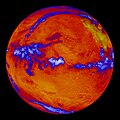Datei:World Heat Engine.jpg
aus Wikipedia, der freien Enzyklopädie

Größe dieser Vorschau: 600 × 600 Pixel. Weitere Auflösungen: 240 × 240 Pixel | 480 × 480 Pixel | 768 × 768 Pixel | 1.024 × 1.024 Pixel | 2.048 × 2.048 Pixel | 3.000 × 3.000 Pixel.
Originaldatei (3.000 × 3.000 Pixel, Dateigröße: 551 KB, MIME-Typ: image/jpeg)
Dateiversionen
Klicke auf einen Zeitpunkt, um diese Version zu laden.
| Version vom | Vorschaubild | Maße | Benutzer | Kommentar | |
|---|---|---|---|---|---|
| aktuell | 14:06, 14. Okt. 2010 |  | 3.000 × 3.000 (551 KB) | wikimediacommons>Alpha30 | {{Information |Description='''Collection:''' The World Revs its Heat Engine, from: NASA Marshall Space Flight Center Collection. Compilation of NASA, stills, film and video, created in partnership with Internet Archive. Image n.0300805 |Source=[http://www |
Dateiverwendung
Die folgende Seite verwendet diese Datei:

